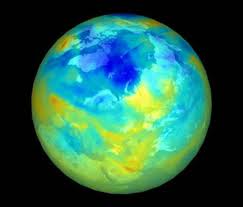
Arctic ozone hole - credit:NASA
According to the study, published online Sunday in the journal Nature, there was what NASA calls “an unprecedented depletion of Earth’s protective ozone layer above the Arctic last winter and spring.” The agency sites the cause of the depletion in ozone as an “unusually prolonged period of extremely low temperatures in the stratosphere.”
The size of the hole in the ozone over the Arctic is very similar to the size of the one which appears over the Antarctic each winter. Without this protective layer, harmful ultraviolet rays from the sun pass directly to the surface of the Earth.
To investigate the 2011 Arctic ozone loss, scientists from 19 institutions in nine countries (United States, Germany, The Netherlands, Canada, Russia, Finland, Denmark, Japan and Spain) analyzed a comprehensive set of measurements.
These included daily global observations of trace gases and clouds from NASA’s Aura and CALIPSO spacecraft; ozone measured by instrumented balloons; meteorological data and atmospheric models. The scientists found that at some altitudes, the cold period in the Arctic lasted more than 30 days longer in 2011 than in any previously studied Arctic winter, leading to the unprecedented ozone loss. Further studies are needed to determine what factors caused the cold period to last so long.
“Day-to-day temperatures in the 2010-11 Arctic winter did not reach lower values than in previous cold Arctic winters,” said lead author Gloria Manney of NASA’s Jet Propulsion Laboratory in Pasadena, Calif., and the New Mexico Institute of Mining and Technology in Socorro. “The difference from previous winters is that temperatures were low enough to produce ozone-destroying forms of chlorine for a much longer time. This implies that if winter Arctic stratospheric temperatures drop just slightly in the future, for example as a result of climate change, then severe Arctic ozone loss may occur more frequently.”
The 2011 Arctic ozone loss occurred over an area considerably smaller than that of the Antarctic ozone holes. This is because the Arctic polar vortex, a persistent large-scale cyclone within which the ozone loss takes place, was about 40 percent smaller than a typical Antarctic vortex. While smaller and shorter-lived than its Antarctic counterpart, the Arctic polar vortex is more mobile, often moving over densely populated northern regions. Decreases in overhead ozone lead to increases in surface ultraviolet radiation, which are known to have adverse effects on humans and other life forms.
Although the total amount of Arctic ozone measured was much more than twice that typically seen in an Antarctic spring, the amount destroyed was comparable to that in some previous Antarctic ozone holes. This is because ozone levels at the beginning of Arctic winter are typically much greater than those at the beginning of Antarctic winter.
Manney said that without the 1989 Montreal Protocol, an international treaty limiting production of ozone-depleting substances, chlorine levels already would be so high that an Arctic ozone hole would form every spring. The long atmospheric lifetimes of ozone-depleting chemicals already in the atmosphere mean that Antarctic ozone holes, and the possibility of future severe Arctic ozone loss, will continue for decades.
“Our ability to quantify polar ozone loss and associated processes will be reduced in the future when NASA’s Aura and CALIPSO spacecraft, whose trace gas and cloud measurements were central to this study, reach the end of their operational lifetimes,” Manney said. “It is imperative that this capability be maintained if we are to reliably predict future ozone loss in a changing climate.”
For more information on NASA’s Aura mission, visit: http://www.nasa.gov/aura
For more information on NASA’s CALIPSO mission, visit: http://www.nasa.gov/calypso
![Herbal Reference Substances are Key to Everyday Products <!-- AddThis Sharing Buttons above -->
<div class="addthis_toolbox addthis_default_style " addthis:url='http://newstaar.com/herbal-reference-substances-are-key-to-everyday-products/3512112/' >
<a class="addthis_button_facebook_like" fb:like:layout="button_count"></a>
<a class="addthis_button_tweet"></a>
<a class="addthis_button_pinterest_pinit"></a>
<a class="addthis_counter addthis_pill_style"></a>
</div>When it comes to quality control testing and the development of new products, Botanical Reference Materials (BRMs), also known as Herbal References are critically important. To help companies ultimately obtain all-important FDA approval, the Food and Drug Administration provides in its guidance a recommendation that […]<!-- AddThis Sharing Buttons below -->
<div class="addthis_toolbox addthis_default_style addthis_32x32_style" addthis:url='http://newstaar.com/herbal-reference-substances-are-key-to-everyday-products/3512112/' >
<a class="addthis_button_preferred_1"></a>
<a class="addthis_button_preferred_2"></a>
<a class="addthis_button_preferred_3"></a>
<a class="addthis_button_preferred_4"></a>
<a class="addthis_button_compact"></a>
<a class="addthis_counter addthis_bubble_style"></a>
</div>](http://newstaar.com/wp-content/uploads/2021/02/Achillea_millefolium_flowers-100x100.jpg)
![Quality Electrochemical Biosensors are Critical for Medical, Food and Chemical Industry <!-- AddThis Sharing Buttons above -->
<div class="addthis_toolbox addthis_default_style " addthis:url='http://newstaar.com/quality-electrochemical-biosensors-are-critical-for-medical-food-and-chemical-industry/3512086/' >
<a class="addthis_button_facebook_like" fb:like:layout="button_count"></a>
<a class="addthis_button_tweet"></a>
<a class="addthis_button_pinterest_pinit"></a>
<a class="addthis_counter addthis_pill_style"></a>
</div>A number of industries have, at their core, a need to frequent or even continuous analysis of biological media. These include the medical and pharmaceutical fields, biotech firms, and food and chemical companies. To maintain quality standards and develop new products, these industries rely heavily […]<!-- AddThis Sharing Buttons below -->
<div class="addthis_toolbox addthis_default_style addthis_32x32_style" addthis:url='http://newstaar.com/quality-electrochemical-biosensors-are-critical-for-medical-food-and-chemical-industry/3512086/' >
<a class="addthis_button_preferred_1"></a>
<a class="addthis_button_preferred_2"></a>
<a class="addthis_button_preferred_3"></a>
<a class="addthis_button_preferred_4"></a>
<a class="addthis_button_compact"></a>
<a class="addthis_counter addthis_bubble_style"></a>
</div>](http://newstaar.com/wp-content/uploads/2020/10/Electrochemical-Biosensor-100x100.jpg)
![Company Develops Industrial Mixers Well-Suited for both Fragile and Explosive Products <!-- AddThis Sharing Buttons above -->
<div class="addthis_toolbox addthis_default_style " addthis:url='http://newstaar.com/company-develops-industrial-mixers-well-suited-for-both-fragile-and-explosive-products/3512071/' >
<a class="addthis_button_facebook_like" fb:like:layout="button_count"></a>
<a class="addthis_button_tweet"></a>
<a class="addthis_button_pinterest_pinit"></a>
<a class="addthis_counter addthis_pill_style"></a>
</div>Industrial drum mixers are normally applied to blend mixes of varying viscosities such as adhesive slurries or cement. Some of these mixers have the capability of blending mixes of very different particle sizes such as fruit and ice cream, and gravel and cement slurry. The […]<!-- AddThis Sharing Buttons below -->
<div class="addthis_toolbox addthis_default_style addthis_32x32_style" addthis:url='http://newstaar.com/company-develops-industrial-mixers-well-suited-for-both-fragile-and-explosive-products/3512071/' >
<a class="addthis_button_preferred_1"></a>
<a class="addthis_button_preferred_2"></a>
<a class="addthis_button_preferred_3"></a>
<a class="addthis_button_preferred_4"></a>
<a class="addthis_button_compact"></a>
<a class="addthis_counter addthis_bubble_style"></a>
</div>](http://newstaar.com/wp-content/uploads/2020/06/bandeau-sofragir2-100x100.jpg)